Buen camino
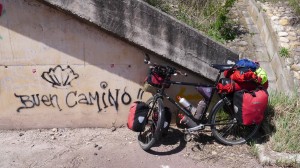 The familiar greeting of “Buen Camino!” (literally meaning ‘good road’) amongst fellow pilgrims personifies the friendliness and camaraderie amongst the wayfarers who travel along the Way of St James. Often carrying a scallop shell and occasionally a gourd to signify their pilgrim status – and to ward off thieves or those with less than honourable intentions – the vast majority of pilgrims walk whilst a minority, including myself, cycle the route. I’ve already met a Dutch couple who are travelling with their young son on brightly coloured recumbents festooned with flags; gangs of lycra-clad mountain bikers in search of the next adrenalin rush; cycle-tourers on tandem bikes; and even a group of German farmers that have driven their lovingly restored tractors all the way from Kesslingen, Germany. Whilst the mode of locomotion may be different, the sentiments in the shared goodwill of the expression, ‘Buen Camino’, amongst walkers, cyclists, and tractor-enthusiasts alike remains exactly the same.
The familiar greeting of “Buen Camino!” (literally meaning ‘good road’) amongst fellow pilgrims personifies the friendliness and camaraderie amongst the wayfarers who travel along the Way of St James. Often carrying a scallop shell and occasionally a gourd to signify their pilgrim status – and to ward off thieves or those with less than honourable intentions – the vast majority of pilgrims walk whilst a minority, including myself, cycle the route. I’ve already met a Dutch couple who are travelling with their young son on brightly coloured recumbents festooned with flags; gangs of lycra-clad mountain bikers in search of the next adrenalin rush; cycle-tourers on tandem bikes; and even a group of German farmers that have driven their lovingly restored tractors all the way from Kesslingen, Germany. Whilst the mode of locomotion may be different, the sentiments in the shared goodwill of the expression, ‘Buen Camino’, amongst walkers, cyclists, and tractor-enthusiasts alike remains exactly the same.
The ride from Roncesvalles into the Basque stronghold of Pamplona, the first main city along the Camino de Santiago, was an exhilarating one. I chose to take the road so that I could enjoy the twists and turns as it unravelled through the Valle de Erro. Woefully lost trying to navigate the spaghetti junctions of dual-carriage ways that orbit the city, charitable locals clearly saw my increasing desperation with the map and pointed me in the direction of my refuge for the night. 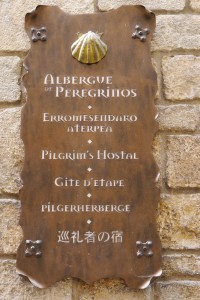 Thankfully, I soon found the Albergue de Peregrinos de Jesús y Maria close to the cathedral nestled unassumingly in one of the many narrow cobbled streets of the beautiful medieval quarter. It is here that I was first introduced to the chorus of snores that have become the nigh-time soundtrack to the handful of Albergues that I have stayed in along the way.
Thankfully, I soon found the Albergue de Peregrinos de Jesús y Maria close to the cathedral nestled unassumingly in one of the many narrow cobbled streets of the beautiful medieval quarter. It is here that I was first introduced to the chorus of snores that have become the nigh-time soundtrack to the handful of Albergues that I have stayed in along the way.
Often run by volunteers, an Albergue is basically a hostel for pilgrims that charge anything between 5-10 Euros or simply ask for a donation for the luxury – and I do mean luxury – of a shower and bunk bed for the night. This privilege is only afforded to pilgrims and the Credencial del Peregrino must be presented on arrival for refuge to be granted. In return, a distinctive stamp confirms that the pilgrim has stopped for the night before contin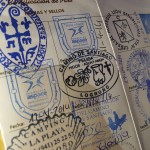 uing their pilgrimage the following day. It also represents a record of the way-points that pilgrims have journeyed along the road towards Santiago de Compostela.
uing their pilgrimage the following day. It also represents a record of the way-points that pilgrims have journeyed along the road towards Santiago de Compostela.
Having been used to starting my day at a leisurely pace which first involves firing up the stove for an invigorating brew before packing up the tent to avoid unwanted attention from a local farmer or the Guardia Civil, I was surprised to see pilgrims at the Albergue set out to begin their day’s walk before the sun had even risen. We all travel at our own pace and rhythm but, personally, coffee always comes before cycling if the day is to get off to a good start. Without doubt, Albergues are exceptionally social places and a great opportunity to meet fellow pilgrims even if the symphony of snores at night keeps slumber a distant prospect – even for even the heaviest of sleepers.
 Following a day’s rest to explore the lively city – mindful to stay well clear of any charging bulls – and with only a few hours’ wakeful kip under the belt, I pushed on to enjoy a succession of wild camps that took me though the fertile grape-growing plains of Navarra and La Rioja. The first green shoots heralding this year’s harvest for wine-production on an industrial scale were beginning to emerge. Spring had indeed finally sprung and the roadside verges that fence off the few fields left to fallow were sprinkled with bright yellow dandelions and buttercups.
Following a day’s rest to explore the lively city – mindful to stay well clear of any charging bulls – and with only a few hours’ wakeful kip under the belt, I pushed on to enjoy a succession of wild camps that took me though the fertile grape-growing plains of Navarra and La Rioja. The first green shoots heralding this year’s harvest for wine-production on an industrial scale were beginning to emerge. Spring had indeed finally sprung and the roadside verges that fence off the few fields left to fallow were sprinkled with bright yellow dandelions and buttercups.
Stopping off in the historic town of Santo Domingo de la Calzada situated on the banks of the Oja River for a typical lunch of cheese and fresh bread, I got chatting to a local woman, Maria, who was sharing quality time with her baby daughter in the shade of the town square. As we talked, I beckoned her towards me with an encouraging ‘hola!’ and to her mother’s astonishment, Eva began to take her very first steps: It’s the small but extraordinary experiences on the road that take on the greatest poignancy. As in life, a journey of a thousand miles begins with the first step, but is it really the destination or the journey itself that truly matters?
One of the many striking features of the El Camino is the wonderful mix of natural landscapes, flora and fauna that it takes you through. From flat, wide-open agricultural plains that stretch out from Burgos as far as the eye can see to the fresh pine forests and carpets of ferns and wild herbs that cling to the mountain range of the snow-capped Montes de León; or the lush green rolling hills of Galicia that is so reminiscent of Wales or Ireland that I have had to continually remind myself that I am in Spain.  The route takes you through small rural hamlets with crumbling centuries-old farmhouses covered in moss and creeping ivy, over ancient cobbled Roman bridges, alongside gurgling brooks and into quiet, peaceful town squares complete with ornate water fonts offering thirst-quenching respite for the travel-weary pilgrim. The journey has so far been undeniably a kaleidoscope of colour, sights and smells that lift the spirit, nourish the mind and rejuvenate the soul.
The route takes you through small rural hamlets with crumbling centuries-old farmhouses covered in moss and creeping ivy, over ancient cobbled Roman bridges, alongside gurgling brooks and into quiet, peaceful town squares complete with ornate water fonts offering thirst-quenching respite for the travel-weary pilgrim. The journey has so far been undeniably a kaleidoscope of colour, sights and smells that lift the spirit, nourish the mind and rejuvenate the soul.
 The rich experiences that camping affords along this geographical fused-storyboard of Christian and Celtic landmarks has been nothing short of awe-inspiring. I’ve camped under stars framed by the lofty arches of the 12th century ruins of the Convento de San Anton – that once served as a hospital to treat the sick and ailments of passing pilgrims during the medieval ages – and have taken refuge from the howling wind and rain in the shelter of small chapels that overlook the Atapuerca Sierra that was first inhabited by some of the earliest human settlers in Europe.
The rich experiences that camping affords along this geographical fused-storyboard of Christian and Celtic landmarks has been nothing short of awe-inspiring. I’ve camped under stars framed by the lofty arches of the 12th century ruins of the Convento de San Anton – that once served as a hospital to treat the sick and ailments of passing pilgrims during the medieval ages – and have taken refuge from the howling wind and rain in the shelter of small chapels that overlook the Atapuerca Sierra that was first inhabited by some of the earliest human settlers in Europe.
Nature always plays its inevitable hand too. I’ve been woken up more than once by the bad-tempered barks of what I can only imagine are from Wild Boar and have shared my breakfast with a curious Stoat. In so far as the elements are concerned, I’ve been frozen into my tent after being forced to strike camp close to the Cruz de Ferro on the ridge of the Montes de León in a freak snow storm.  The next morning – after a freezing night of fitful sleep above 1500m where I discovered that a hastily prepared hot chocolate on the stove in the early hours can make the difference between cocoa heaven and the onset of hypothermia – I watched the sun rise above the clouds and was treated to a warm hug and coffee shortly after breaking camp by an angel from Normandy. As the feeling to my hands returned, she told me that her name was Anneline, who had been so touched by travelling the northern coastal route of El Camino the previous year that she had decided to give up her philosophy studies at university and practice a philosophy of life that revolves around living off the land and offering coffee and cake to pilgrim’s as they reach the highest point of the route across the Iberian peninsula.
The next morning – after a freezing night of fitful sleep above 1500m where I discovered that a hastily prepared hot chocolate on the stove in the early hours can make the difference between cocoa heaven and the onset of hypothermia – I watched the sun rise above the clouds and was treated to a warm hug and coffee shortly after breaking camp by an angel from Normandy. As the feeling to my hands returned, she told me that her name was Anneline, who had been so touched by travelling the northern coastal route of El Camino the previous year that she had decided to give up her philosophy studies at university and practice a philosophy of life that revolves around living off the land and offering coffee and cake to pilgrim’s as they reach the highest point of the route across the Iberian peninsula.
Like Anneline, there are many people who live on – and from – El Camino. Take Sergio from France, who said ‘au revoir’ to his Parisian life and has for nearly the past three decades lived on various sections of The Way of St James, picking litter as he goes. Soon to embark on his 24th pilgrimage to date. He told me that it is to mark the anniversary of St Francis of Assisi who made a pilgrimage to Santiago de Compostela 800 years-ago this year. When I enquired how long it would take him to walk the route from the Italian spiritual centre of Assisi to Santiago, Sergio replied matter-of-factly: “Three months, give or take a few.” Or there is David from Barcelona, who renounced his life in the Catalan capital six years ago to live a life of simplicity offering service to pilgrims who should pass by and stop at his humble makeshift home outside the historic-walled city of Astorga.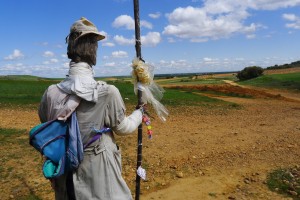 “Life is process,” he mused as he broke up some wood to fuel the flames so I could enjoy a coffee brewed on the fire, whilst he drank herbal tea.
“Life is process,” he mused as he broke up some wood to fuel the flames so I could enjoy a coffee brewed on the fire, whilst he drank herbal tea.
Apart from those that have decided to make a life from El Camino, there are of course the pilgrims themselves. Just like myself, all make the journey for uniquely personal reasons. I’ve met so many amazing people along the way, it’s not possible to accurately recount or do justice to the conversations I’ve shared but the common theme has been a desire to slow the pace of life down and reconnect with themselves, and others: There is Klaus, an art therapist from Munich, who says he is in need of some therapy himself. Or Bruno, from Lake Garda in northern Italy, who is cycling a furious 100km plus a day to carry a banner of get well wishes in his backpack for his ex-wife who is battling for her life after a heart-bypass. Then there is Miquel from Logroño, who wants to give up his addiction to alcohol and television. Or Tina and Marchant from Australia and Poland respectively, who have decided to spend their honeymoon walking El Camino before they get married just make sure they are truly compatible in wedlock. Meanwhile, Zoe from South Korea is looking for love along the way. And then there is Ben, a happy-go-lucky horticulturist student who is walking the route before he starts his internship simply because it is “fun”! And it sure is fun.
Then there is Miquel from Logroño, who wants to give up his addiction to alcohol and television. Or Tina and Marchant from Australia and Poland respectively, who have decided to spend their honeymoon walking El Camino before they get married just make sure they are truly compatible in wedlock. Meanwhile, Zoe from South Korea is looking for love along the way. And then there is Ben, a happy-go-lucky horticulturist student who is walking the route before he starts his internship simply because it is “fun”! And it sure is fun.
For me, the penny truly dropped as I was talking to an Italian pilgrim, Mau, who had a monastic air about him and had met his partner, Nia, on the Way of St James six years-ago. He says they never reached Santiago but ended up settling in the peaceful town of Castrojeriz, in the central municipality of Castilla y León, just a few kilometres down the road from the Convento de San Anton. Aptly called the Hospital de Alma (Hospital of the Soul), they have spent the last couple of years restoring an old Castilian barn into a place of contemplation to remind pilgrims that the Camino is not completed by two feet or, indeed, two wheels; rather – the journey takes place within.
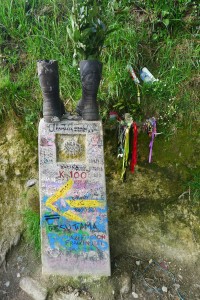 A striking photographic exhibition situated in the entrance to the building, Chasing the Shadows, takes an interesting perspective into the notion of pilgrimage and why increasingly more people each year are compelled to embark on one. The central message is universal. Just like the first steps that Eva took in the square in Santo Domingo de la Calzada, we walk because it is both a naturally innate human desire to do so but also an external expression of our own inner state. It is in this sense that the repetition of walking – or turning of the pedals – becomes not just an act of simply getting from A to B, but a means of processing the habitual nature of life so that we can gain a deeper understand of ourselves. In short, we become the Camino.
A striking photographic exhibition situated in the entrance to the building, Chasing the Shadows, takes an interesting perspective into the notion of pilgrimage and why increasingly more people each year are compelled to embark on one. The central message is universal. Just like the first steps that Eva took in the square in Santo Domingo de la Calzada, we walk because it is both a naturally innate human desire to do so but also an external expression of our own inner state. It is in this sense that the repetition of walking – or turning of the pedals – becomes not just an act of simply getting from A to B, but a means of processing the habitual nature of life so that we can gain a deeper understand of ourselves. In short, we become the Camino.
Without any ceremony, I doggedly pushed the Sherpa into the Plaza del Obradoiro overlooked by the soaring spires of the Cathedral of Santiago de Compostela exactly on the count of ten; totally exhausted but elated. I was exhausted because I was recovering from a marathon night ride with only the brilliant beam of my headlight to light the way down empty lanes as bats swirled above, rabbits darted left and right, and owls hooted from the shadows of the trees in their familiar but haunting call and response. Jolted by the deeply sad news of the departure of my grandfather from this life – a kind, gentle Yorkshireman with a big heart and who always had a twinkle in his eyes – I could not stop until I had finally reached Santiago fuelled only by impromptu coffee stops brewed on the stove with lashings of sweet honey in the still of night.
I felt elated because I was entering a revered space that for centuries, countless pilgrims have risked life and limb to journey there. It is hard to explain, but is was as if the collective memory of emotions resonating in those worn granite stones embraced my heart in one singular moment, and I became overwhelmed with joy and sadness as I lit a candle for the loss of a dearly loved family relative. After more than 1200km on the road since arriving in Bilbao one month earlier, I had finally made it to Santiago de Compostela – almost to the day. 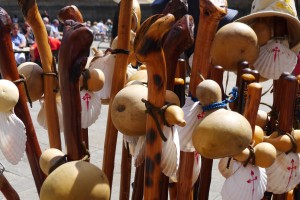 Next stop… to the ‘end of the flat world’ at Cape Finisterre on the Atlantic Coast.
Next stop… to the ‘end of the flat world’ at Cape Finisterre on the Atlantic Coast.